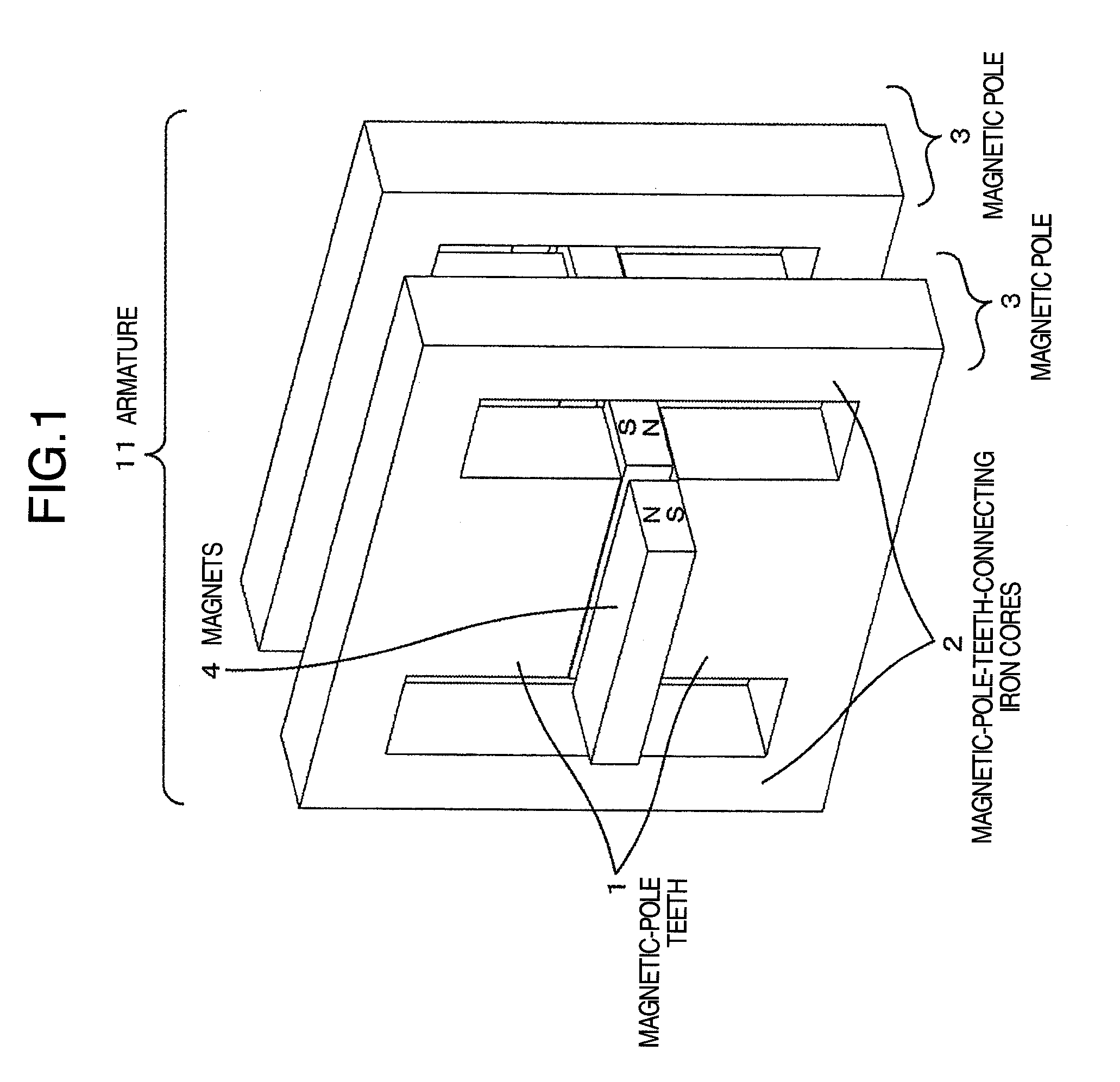Linear motor
a linear motor and motor shaft technology, applied in the field of linear motors, can solve the problems of increasing the above-described leakage magnetic flux, lowering thrust, and leaking magnetic flux out to the adjacent magnetic poles, so as to reduce the leakage of magnetic flux, increase thrust, and reduce thrust pulsation
- Summary
- Abstract
- Description
- Claims
- Application Information
AI Technical Summary
Benefits of technology
Problems solved by technology
Method used
Image
Examples
1st embodiment
[0051]The description will be given below regarding an embodiment of the present invention. FIG. 1 illustrates the relationship between magnetic poles 3 and permanent magnets 4, both of which constitute an armature 11 of the linear motor according to the embodiment of the present invention. With respect to a magnet array where N poles and S poles of the magnets 4 are arranged in an alternate manner, magnetic-pole teeth 1 are set up over and under the magnets 4 in such a manner that the magnetic-pole teeth 1 sandwich-hold the magnets 4. A magnetic pole 3 is constituted with the upper-side and lower-side magnetic-pole teeth 1 and an iron core 2 for connecting these magnetic-pole teeth 1 to each other. Although, in FIG. 1, a case of the two units of magnetic poles 3 is illustrated, the number of the magnetic poles 3 is not limited thereto.
[0052]FIG. 2 is a diagram for illustrating the detailed configuration of the armature 11. Namely, windings 5 are further included, and are combined w...
2nd embodiment
[0059]FIG. 7 illustrates a second embodiment of the linear motor of the present invention. In FIG. 1, the case of the armature 11 including the two units of magnetic poles 3 has been illustrated. Also, the single magnetic pole 3 is constituted with the magnetic-pole teeth 1 and the iron core 2 for connecting these magnetic-pole teeth 1 to each other. In FIG. 7, however, a case of the armature 11 including the four units of magnetic poles 3 is illustrated. Each of the magnetic poles 3 is configured by multilayering a plurality of thin plate-like magnetic poles. Also, the magnets 4, which are fixed onto a magnet case 6, are arranged in the Z direction such that their N poles and S poles appear in an alternate manner. Flowing an electric current along the windings 5 in this state causes a force to be exerted onto the magnets 4, thereby giving rise to the generation of a Z-direction-oriented thrust. This Z-direction-oriented thrust makes it possible to displace the displacer which inclu...
3rd embodiment
[0061]FIG. 10 illustrates a third embodiment of the linear motor of the present invention. FIG. 10 illustrates the case where the four units of magnetic poles 3 illustrated in FIG. 1 are deployed. Here, the configuration components in the armature are deployed as follows: Namely, with reference to the pitch P between the magnets 4 (i.e., magnet pitch P), the pitch T between the magnetic poles 3 (i.e., magnetic-pole pitch T) is made equal to 2nP (n=1, 2, 3, . . . , i.e., arbitrary integer). In FIG. 10, n=1 is set. When the magnetic poles 3 are deployed on each 2nP basis, the thrust becomes equal to its maximum value. Consideration, however, is given to the case where the magnetic-pole positions are shifted in order to reduce the pulsation of the thrust or the like. In this case, in order to implement the reduction effect on the pulsation component of the thrust corresponding to a lowering in the thrust, it is the most advisable to set the adjustment width d of the magnetic poles 3 in...
PUM
 Login to View More
Login to View More Abstract
Description
Claims
Application Information
 Login to View More
Login to View More - R&D
- Intellectual Property
- Life Sciences
- Materials
- Tech Scout
- Unparalleled Data Quality
- Higher Quality Content
- 60% Fewer Hallucinations
Browse by: Latest US Patents, China's latest patents, Technical Efficacy Thesaurus, Application Domain, Technology Topic, Popular Technical Reports.
© 2025 PatSnap. All rights reserved.Legal|Privacy policy|Modern Slavery Act Transparency Statement|Sitemap|About US| Contact US: help@patsnap.com



